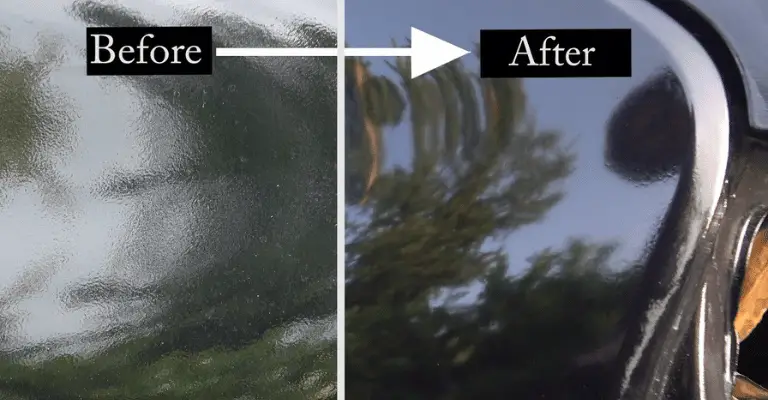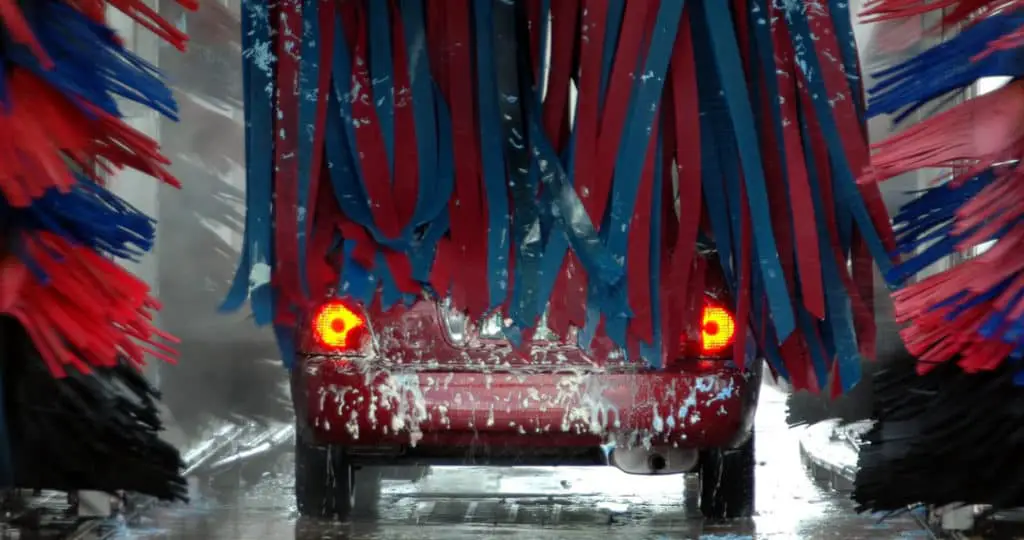- How to Clean Car Carpets Quickly (Without An Extractor) - July 10, 2024
- Can You Touch Up Clear Coat On A Car? Yes and No (Here’s Why) - November 25, 2023
- How To Wax A Car By Hand (For Beginners) - November 14, 2023
Last Updated on January 1, 2025 by Nate Schnell
If you’re a car enthusiast or even a casual vehicle owner, you’ve likely come across the term ‘clear coat.’ But what exactly is it, and why is it so essential for your car’s aesthetic appeal and longevity? In this guide, we’ll dive into what a clear coat does, why it matters, and how you can keep yours in top condition.
What Is a Clear Coat?
A clear coat is a transparent, colorless layer of paint applied over the colored base coat on your car’s exterior. It’s designed to protect the underlying paint and enhance your vehicle’s shine. This glossy layer acts as a shield, safeguarding your car from environmental damage while maintaining its vibrant appearance.
Modern cars almost always have a clear coat as part of their paint job. Without it, your vehicle’s paint would be directly exposed to the elements, leading to quicker wear, fading, and damage.
Why Is a Clear Coat Necessary?
Protection From UV Rays
The sun’s ultraviolet (UV) rays can cause significant damage to your car’s paint over time, leading to fading and a dull appearance. A clear coat acts like sunscreen for your car, blocking UV rays and preserving the paint’s color and vibrancy.
Resistance to Surface Damage
Your car’s clear coat also provides a barrier against minor scratches, bird droppings, acid rain, and other contaminants. With a healthy clear coat, shallow imperfections can often be buffed out without affecting the paint underneath.
Enhancing Aesthetics
Clear coats create the glossy, polished look that many car owners love. They make the color appear deeper and more vibrant, giving your vehicle that showroom-quality finish.
What Happens Without a Clear Coat?
Without a clear coat, your car’s paint is vulnerable to damage. UV rays, pollutants, and environmental debris can eat away at the base coat, leaving your car looking dull and weathered. Additionally, scratches that penetrate the base coat can expose the metal underneath, leading to rust and further deterioration.
A vehicle without a clear coat also lacks the high-gloss finish that gives cars their sleek, modern appearance. Instead, the paint may have a matte or flat look, which is less appealing to many car owners.
How to Protect Your Clear Coat
Wash Your Car Regularly
Dirt, grime, and road debris can wear down your clear coat over time. Washing your car at least once a month with a pH-neutral soap helps remove contaminants that might otherwise degrade the surface. Use a soft microfiber cloth or sponge to avoid scratching the clear coat during cleaning.
Avoid Direct Sunlight
Prolonged exposure to sunlight can weaken the clear coat, causing it to fade or become brittle. Whenever possible, park in the shade or use a car cover to minimize UV exposure.
Use Paint Sealants
Applying a paint sealant like wax or ceramic coating can provide an additional layer of protection for your clear coat. These products enhance the clear coat’s durability and preserve the car’s shine for longer.
Clay Bar Treatments
Using a clay bar helps remove embedded contaminants that washing alone can’t tackle. This treatment leaves the clear coat smooth and prepares it for waxing or sealing.
Advanced Options for Clear Coat Protection
Paint Protection Films (PPF)
Paint protection films are clear, thermoplastic urethane layers applied to your car’s surface. They offer excellent protection against chips, scratches, and environmental damage. PPF is a great choice for high-impact areas like the hood, bumper, and fenders.
Ceramic Coatings
Ceramic coatings bond with your car’s clear coat to create a semi-permanent protective layer. These coatings are highly durable, water-repellent, and resistant to heat, UV rays, and minor scratches. They also enhance your car’s gloss, making it look sleek and polished.
How to Maintain a Failing Clear Coat
If your clear coat starts peeling or fading, immediate action is crucial. Neglecting the issue can expose the base coat, leading to more significant damage. Here are your options:
- Spot Repairs: For minor peeling, you can sand and reapply the clear coat in affected areas.
- Professional Reapplication: If the damage is extensive, it’s best to have the clear coat reapplied professionally to restore your car’s appearance and protection.
- Full Repaint: In severe cases where both the clear coat and base coat are compromised, a complete repaint may be necessary.
FAQs About Clear Coats
Can I Apply a Clear Coat Myself?
Yes, but it requires precision and proper tools. Mistakes during application can lead to uneven coverage or further damage. Professional application is recommended for best results.
How Often Should I Wax My Car to Maintain the Clear Coat?
Waxing every three months is ideal. Wax adds an extra layer of protection to the clear coat and enhances its shine.
What Happens if I Don’t Address Peeling Clear Coat?
Peeling clear coat exposes the base coat, leaving it vulnerable to environmental damage. Over time, this can lead to fading, rust, and costly repairs.
Conclusion
A clear coat is an essential part of your car’s paint job, offering both protection and aesthetic appeal. By understanding its importance and following proper maintenance practices, you can ensure your car stays vibrant and glossy for years to come. Whether through regular washing, waxing, or advanced solutions like ceramic coatings, caring for your clear coat is a small investment that pays off in the long run. Keep your car shining and protected!



